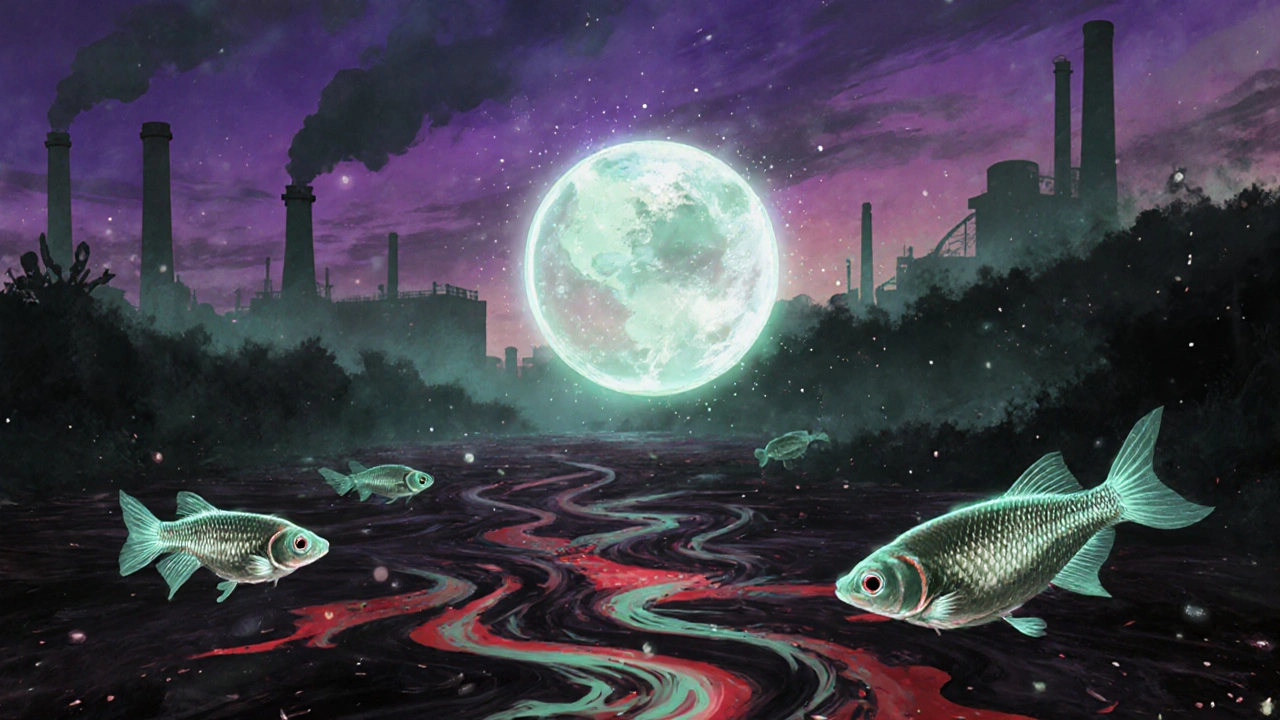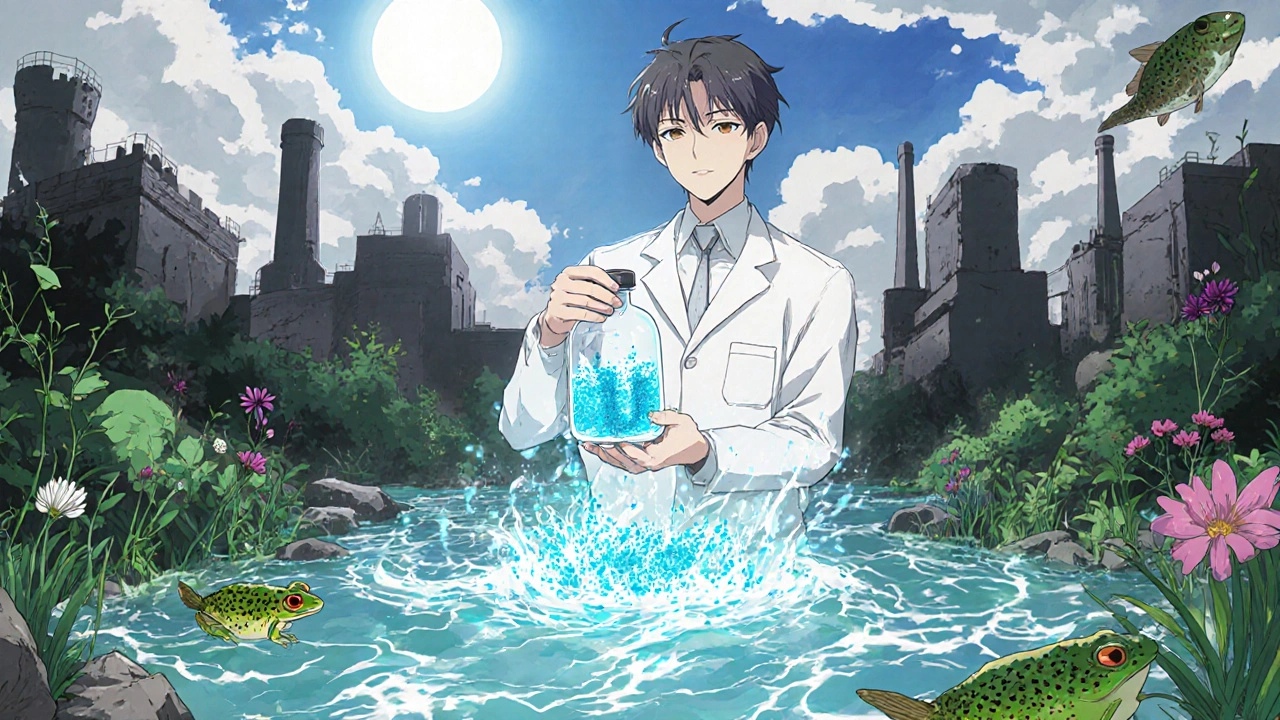The Environmental Impact of Dabigatran Manufacturing and Disposal

Every year, millions of people take dabigatran to prevent strokes and blood clots. It’s a life-saving drug, sold under the brand name Pradaxa. But behind every pill is a hidden cost: the environmental toll of making it and getting rid of it. Most people don’t think about where their medicine comes from after they swallow it. But the truth is, pharmaceutical manufacturing and disposal are quietly polluting waterways, soil, and even the air we breathe.
How Dabigatran Is Made - And Why It Leaves a Trace
Dabigatran is a synthetic molecule, not something you can extract from plants or animals. That means every gram of it has to be built from scratch in a chemical plant. The process involves at least 12 chemical reactions, many using solvents like dichloromethane, acetonitrile, and toluene - all toxic, volatile, and hard to fully capture.
According to a 2023 study by the European Chemicals Agency, producing one kilogram of dabigatran generates roughly 80 kilograms of waste. That’s 80 times the weight of the final product. Most of that waste is liquid, containing unreacted chemicals, heavy metal catalysts like palladium, and residual solvents. Even with modern filtration, about 5-10% of these compounds escape into wastewater systems.
Pharmaceutical factories in India and China - where most generic dabigatran is made - often lack the advanced treatment systems found in the EU or U.S. A 2024 analysis of effluent from seven manufacturing sites found dabigatran-related compounds in river samples at concentrations up to 1.2 micrograms per liter. That’s below human safety limits, but far above what aquatic life can tolerate.
What Happens When Dabigatran Enters Water Systems
People don’t flush pills anymore - most dispose of them in the trash. But here’s the problem: dabigatran doesn’t break down easily. In landfills, it can leach into groundwater. In cities with combined sewer systems, even flushed pills end up in treatment plants that aren’t designed to remove complex organic molecules like dabigatran.
Studies from the University of California and the Karolinska Institute show that dabigatran and its primary metabolite, dabigatran etexilate, survive conventional wastewater treatment. They show up in rivers, lakes, and even drinking water sources in trace amounts. While these levels are too low to affect humans, they’re not harmless to fish and amphibians.
Lab tests on zebrafish exposed to 0.5 micrograms per liter of dabigatran showed disrupted blood clotting behavior - the same mechanism the drug is meant to control in humans. Frogs exposed to similar levels had abnormal development of their cardiovascular systems. These aren’t lab anomalies. They’re early warnings. Aquatic organisms don’t have the same metabolic pathways as humans. What’s safe for us can be deadly for them.

Disposal Practices Are Still Outdated
Many pharmacies offer take-back programs. But in the U.S., fewer than 15% of patients use them. In rural areas, it’s often less than 5%. Most people just toss unused pills in the trash. And even when collected, the pills don’t always get destroyed properly.
Incineration is the gold standard - burning drugs at over 1,000°C destroys nearly all organic compounds. But not all waste facilities can do that. Some just compact and bury them. Others send them to municipal landfills where rainwater washes chemicals into the soil. A 2025 audit of 12 U.S. pharmacy take-back programs found that 38% of collected dabigatran ended up in landfills because the facilities lacked high-temperature incinerators.
And then there’s the issue of expired stock. Pharmacies and hospitals regularly discard large batches. A single hospital might throw out 200-500 bottles of dabigatran a year. Multiply that by thousands of facilities worldwide, and you’re talking about tons of active pharmaceutical ingredients entering the waste stream annually.
Who’s Responsible? And What’s Being Done?
The pharmaceutical industry argues they follow regulations. And technically, they do - in the countries where they’re based. But global supply chains mean production often happens where environmental rules are weaker. The EU has stricter limits on solvent emissions and requires pharmaceutical companies to report their environmental impact. The U.S. FDA has no such requirement for manufacturing waste.
Some companies are starting to change. Boehringer Ingelheim, the original maker of Pradaxa, began investing in green chemistry in 2022. They redesigned two steps in the dabigatran synthesis to eliminate dichloromethane and reduce solvent use by 60%. They also installed closed-loop recycling for acetonitrile. It cost $40 million upfront - but cut waste disposal costs by 45% within two years.
Other manufacturers are following. Generic makers are slower to adopt these changes. Cost is the main barrier. A single batch of generic dabigatran sells for under $0.10 per pill. There’s little financial incentive to spend extra on cleaner production - unless regulators force it.

What Patients Can Do
You don’t need to stop taking dabigatran. But you can help reduce its environmental footprint.
- Only fill prescriptions you’ll use. Don’t stockpile.
- Use pharmacy take-back programs. Ask your pharmacist where they send collected drugs.
- Never flush pills - even if the label says you can. That advice is outdated.
- If no take-back is available, mix unused pills with coffee grounds or cat litter in a sealed container before throwing them in the trash. This makes them less appealing to pets or scavengers and slows leaching.
- Support policies that require pharmaceutical manufacturers to fund and manage end-of-life disposal.
These actions won’t fix the system alone. But they reduce pressure on landfills and water systems. And they send a signal: patients care about where their medicine comes from - and where it goes.
The Bigger Picture: Medicine and the Environment
Dabigatran isn’t unique. Similar issues exist with statins, antidepressants, antibiotics, and birth control pills. But dabigatran is a good example because it’s widely used, chemically stable, and hard to break down. It’s a poster child for a growing crisis: modern medicine is built on chemistry that doesn’t respect nature’s cycles.
The solution isn’t to stop making drugs. It’s to redesign them. Scientists are now working on “benign-by-design” pharmaceuticals - molecules that work just as well but break down quickly in the environment. One such candidate, currently in Phase II trials, has shown 95% degradation in wastewater within 48 hours.
Regulators need to require environmental impact assessments for all new drugs - not just safety and efficacy. And manufacturers need to be held accountable for the full life cycle of their products, from lab to landfill.
For now, the burden falls partly on patients. But real change will come when companies stop treating the environment as an afterthought - and start seeing it as part of their responsibility.
Is dabigatran harmful to humans if it’s in drinking water?
No, current levels of dabigatran found in drinking water are thousands of times lower than the therapeutic dose. There’s no evidence it poses a risk to human health at these concentrations. The concern is for aquatic life, not people.
Can I recycle empty dabigatran bottles?
Yes, most plastic prescription bottles are made from HDPE (recycling code #2) and can be recycled - but only after you remove the label and ensure the bottle is completely empty. Some recycling programs require you to rinse them. Check your local guidelines.
Why don’t wastewater plants remove drugs like dabigatran?
Most wastewater treatment plants were built to remove solids, bacteria, and nutrients - not complex synthetic chemicals. Dabigatran is designed to be stable in the human body, which means it’s also resistant to breakdown in water. Advanced treatment like ozone or activated carbon can remove it, but those systems are expensive and not widely used.
Are generic versions of dabigatran worse for the environment?
The active ingredient is the same, so the environmental impact is similar. But generic manufacturers often use older, less efficient production methods with higher solvent waste. Brand-name makers like Boehringer Ingelheim have invested in greener processes; many generics haven’t - simply because they’re under more price pressure.
What’s being done globally to fix this?
The EU requires environmental risk assessments for all new drugs. Switzerland and Sweden have national take-back programs with high participation. In the U.S., the EPA is studying pharmaceutical pollution but has no mandatory rules yet. The World Health Organization has called for global guidelines, but no binding international standards exist.
William Priest
November 7, 2025 AT 07:03Also, 'dabigatran etexilate' is not a metabolite, it's the prodrug. You clearly didn't read the paper you're quoting. Just sayin'.
Ryan Masuga
November 7, 2025 AT 22:17Maybe we need a system where every pill bottle comes with a prepaid return envelope for unused meds? Simple, low-cost, and it could be part of the prescription process. Small change, big impact.
Jennifer Bedrosian
November 8, 2025 AT 01:40Also can we talk about how gross it is that my pills are in the same landfill as my expired yogurt??
Lashonda Rene
November 8, 2025 AT 10:28It's not about being perfect, it's about trying. Maybe if we all just used take-back programs once a year, it would add up. And maybe if we asked our doctors to talk about this, it would help. It's not that hard to care.
Andy Slack
November 9, 2025 AT 23:34Stop scrolling. Start acting. Take-back programs exist. Use them. Talk to your pharmacist. Demand better. Change doesn't happen because someone else does it. It happens because you do.
Rashmi Mohapatra
November 10, 2025 AT 01:52Abigail Chrisma
November 10, 2025 AT 14:09My mom takes dabigatran and she's 82. She'd be horrified to know her pills are harming fish. But she doesn't know how to dispose of them safely. We need better education, not guilt.
Ankit Yadav
November 11, 2025 AT 18:28Pharma needs to be held accountable at the source. Not the patient. The burden should never be on the person trying to stay alive.
Meghan Rose
November 12, 2025 AT 05:50Also, I'm pretty sure the EPA doesn't care. They're too busy fighting over toilet paper regulations.
Steve Phillips
November 13, 2025 AT 06:17So we’re now supposed to feel guilty for taking a drug that prevents strokes? While the same people who wrote this article probably drive SUVs, eat imported avocados, and fly to Bali for ‘eco-retreats’?
And you blame generic manufacturers? Please. The real villain is the FDA for not requiring environmental impact assessments for decades.
Also, ‘benign-by-design’? That’s a buzzword. It’s not science. It’s marketing.
And don’t get me started on the fact that you didn’t mention the carbon footprint of shipping these pills from India to your CVS.
Stop virtue signaling. Start demanding systemic change - from the regulators, not the patients.
Rachel Puno
November 13, 2025 AT 20:32It's a small question. But if everyone asked it, they'd have to start answering.
Clyde Verdin Jr
November 15, 2025 AT 04:25Next you’ll tell us to stop using antibiotics because they kill bacteria in the river.
Maybe if people stopped being so lazy and just took their meds correctly, we wouldn’t have so many unused pills.
Also, fish don’t have feelings. And if they did, they’d probably be mad at plastic bottles, not dabigatran.